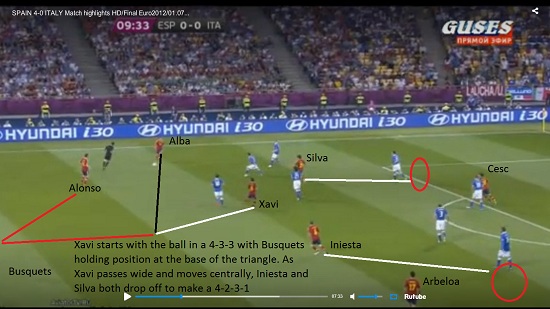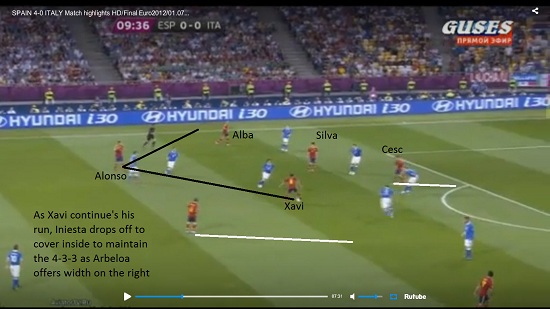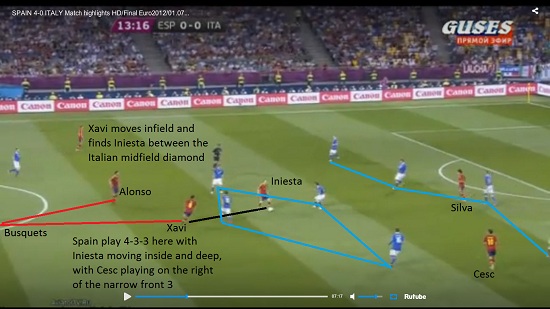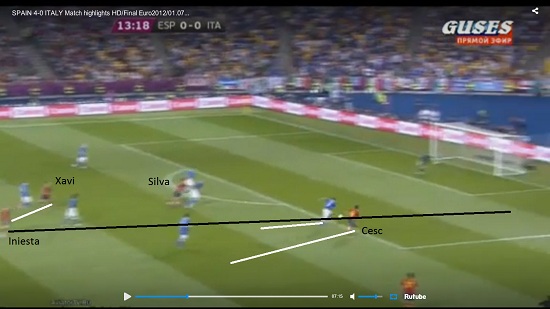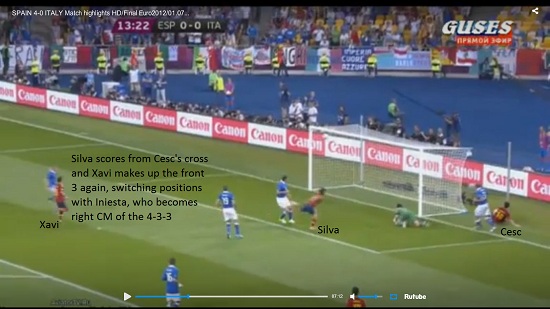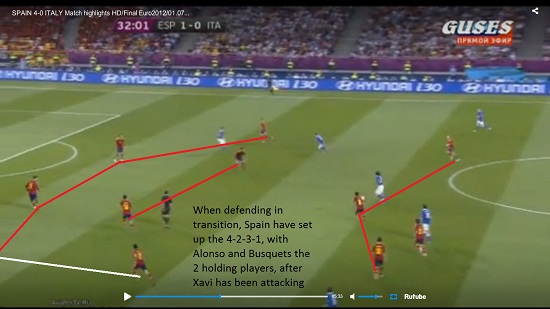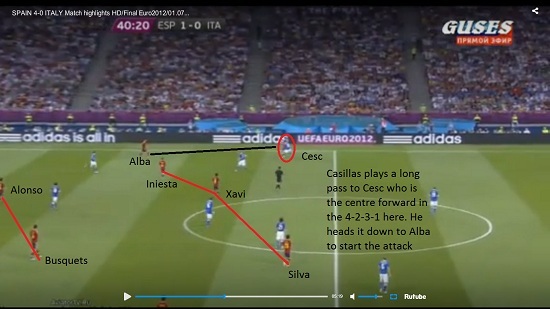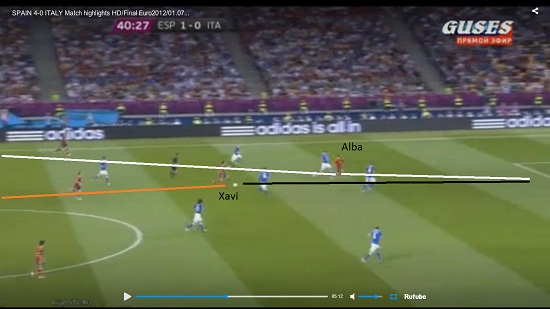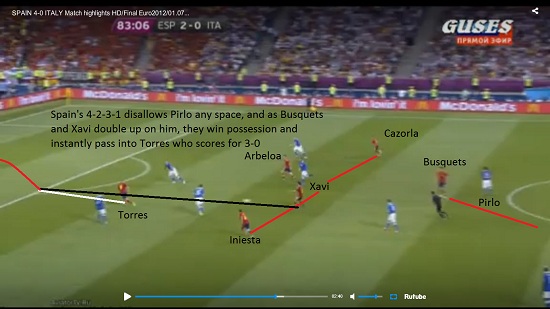| Does Spain Play With a 4-3-3, 4-2-3-1 or Both?
originally posted by Michael Saif on http://www.worldclasscoaching.com/
Spain’s formation is a source of great debate and intrigue. Is it a 4-3-3? Is it a 4-3-3-0? Is it a 4-6-0? Is it a 4-2-3-1? Is it a 4-2-4-0? Is it a 4-2-2-2? I think it’s a combination of the above. Some matches they will ensure they have a central striker, generally Cesc Fabregas, who will rotate this role with David Silva, with Xavi and Iniesta floating around the space between midfield and defense. They play with a narrow attacking 4-2-3-1 or a narrow 4-3-3 as Alba and Arbeloa do a great job or providing width very high up the field and allowing Spain to regularly outnumber teams between defense and midfield, allowing them to play between the lines frequently. In the final where Spain played undoubtedly their best football of the tournament, they played a combination of 4-3-3 and 4-2-3-1, and Xavi’s position dictated the shape. In some attacking phases with the ball in the opposition half, he would drop deep and 2 of the 3 of Silva, Iniesta and Cesc would play in between the defense and midfield with Alba and Arbeloa the full backs on the outside, with the other of the front 3 staying as a central striker. In some defensive transition phases, Spain would revert to a 4-2-3-1 with Alonso and Busquets screening the defense, with Xavi, Iniesta and Silva pressing in front, with Cesc as the main striker. When they win the ball back, they would stay in this formation and confuse the opposition as players positions and the marking responsibilities have changed again. Xavi and Iniesta switch positions – 4-3-3 inside opposition half
Xavi drops into a 4-3-3 as Silva and Iniesta drop off from the front to offer passes from midfield. Xavi passes wide to Alba and moves centrally as Iniesta starts to drop off unmarked. Cesc is holding his marker in position.
As the ball is passed from Alba to Alonso, a space opens up for Xavi to receive in, so Alonso finds the pass into Xavi who takes up the position between the lines. Iniesta is now in Xavi’s position making the 4-3-3 complete again. Cesc checks away from his opponent to offer a 1-2 with Xavi. He moves right as the 1-2 will be returned onto Xavi’s stronger right foot. Silva now makes the run forward to become the main attacker inside the box should Xavi’s shot from Cesc’s pass be saved and rebounded into the box. Note Arbeloa is offering the width on the right, allowing the front 3 to play narrow, and allowing the chance to outnumber Italy in the space between midfield and defense. Xavi breaks from midfield in the 4-3-3, switches with Iniesta again
Xavi receives from Cesc who this time is on the right of the front 3, with Silva occupying the central defenders. Xavi dribbles inside as Iniesta takes up the position between the Italian midfield diamond to receive the pass.
Iniesta takes 1 touch inside the diamond and Cesc see’s that a quick run on the outside of the defence can allow a pass into the space between the defenders and behind the defense. Silva is still the center forward but Xavi is now ahead of Iniesta and will continue the run inside the box to become the 3rd attacker of the front 3.
Xavi is now inside the box ensuring the front 3 are all inside the box, as Silva scores a header from Cesc’s cross. Iniesta has taken up Xavi’s position as right central midfielder in the 4-3-3. Spain defensive shape when the ball Is in their own half – 4-2-3-1
As Italy are good in possession, mainly through Andrea Pirlo, Xavi has been assigned a role of playing close to him as often as possible, and as Pirlo plays at the bottom of the midfield diamond, Xavi can play in the center of the 2-3-1 attack, they will naturally play in similar positions. Here, Xavi is pressing Pirlo while Spain are in a 4-2-3-1, with Alonso and Busquets screening in front of the back 4, playing wide – this is to help protect the full backs as there is no central attacker – both Italy’s attackers are playing wider than the Spain central defenders. Spain 4-2-3-1 attacking from defensive half – Xavi plays in the center of the 2-3-1 attack
Here, Casillas has recovered a loose ball inside the box and Spain have moved out to start a counter attack in transition. Cesc receives the long pass and heads it down to Alba, who takes a touch before finding Xavi in the space between defense and midfield, then sprinting ahead of Cesc to attack the space behind the full back who is with Cesc in the image.
As Xavi receives on the half turn, and as Silva, Cesc and Iniesta are playing deeper because of the speed of the counter attack, Alba breaks forward and offers the pass behind the defense that the center forward would offer, with Xavi in the hole. Xavi finds the killer pass and Alba finishes well for 2-0 at Half time to Spain, and game over. Xavi makes the 3rd goal – 4-2-3-1 pressure on Pirlo wins possession in a dangerous area
Xavi is playing in the same are as Pirlo, so he presses him with Busquets who has pushed out of position ahead of Alonso, and between the two of them dispossess Pirlo. Xavi has a quick scan of the play and finds another killer pass for Torres to score for 3-0 and find his 2nd assist in the 4-2-3-1 formation.
By Stevie Grieve. You can find more tactical material by Grieve, in his Modern Soccer Tactics Volume 1&2 books. These books include tactical insights on teams like Barcelona, Man City, Real Madrid and top players like Ronaldo, Iniesta, Robhino and others as well as drills and practices you can do with your team to replicate these top teams and players. |
|
|



